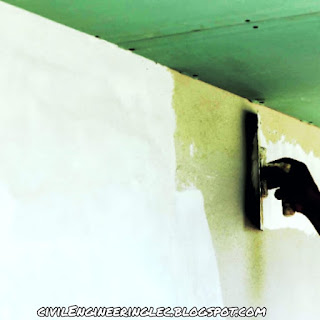Surface
Finishing
The steps involved in cleaning and decorating the
surface of a building structure are called surface finishing.
White
Wash
The process of wetting with lime solution after
plastering the building surface is called White Wash. Sometimes White Wash is
done by adding a color to the solution which is called color wash.
 |
| White Wash |
White Wash Purposes
White Wash
or coloring has the following purposes
·
Make the building look beautiful and
attractive
·
Better diffusion of light rays in the
building.
·
Adherence to the principle of hygiene.
How to White Wash or Color
There are
the following steps to White Wash.
·
Surface preparation
·
White Wash or color preparation
·
The process of White Wash
Surface
Preparation
The building surface is cleaned before whitewash. If the surface is too soft, it is slightly
roughened using Rigmar So that the grip on the white surface becomes
stronger. If there are pits or holes on
the surface, large holes are filled with cement mortar and small holes with
putty. When it matures, the old whiteness is dropped using an iron brush. If
the surface has oil or grease or any other color marks, it is prepared from the
putty of rice and applied on the surface.
Finally the surface is cleaned with a brush to dust.
White
Wash or Color Preparation
Fat lime is used to make whites. Quick Fat Lime Put it in an iron tub or drum, pour water in it and shake it well. During this time heat is released. When the lime is completely dissolved in water, the solution is covered with a thick cloth etc. so that no piece of limestone etc. remains. This solution is diluted as required and a small amount of gum or rice putty is added to it. So that the grip on the white plaster is strong. At this stage some amount of nail is also added so that the finished product shines. If the surface is to be colored, the color is used instead of blue, but the amount of color is kept high.
The
Process of White Wash
The prepared solution is applied to the surface with
a brush. At least three coats are applied to the newly plastered surface. While
on the old surface one coat is enough. In the case of three coats, the first
coat is applied vertically, the second in the horizontal direction and the
third in the vertical position. So that the surface is well moistened but all
three coats must be dried first before applying on top of a second coat. While whitewash the old surface, the first
brush was turned horizontally and immediately turned vertically. While
painting, the solution should be shaken repeatedly so that the colors do not
settle down. Work should not be left unfinished at the end of the day. One
layer of the room where the work has started should be completed in the whole
room.
 |
whitewash |
(https://civilengineeringlec.blogspot.com/2021/02/what-is-civil-engineering-scope.html)
Distempering
The process of applying the distemper to the
finished surface of the building is called distempering. Distempering are used on building surfaces to
achieve the following objectives. Protecting the building from weather effects.
Make the surface smooth and smooth. Blocking the entry of dampness. Make the
building look beautiful and attractive
Distemper is available in powder or solution form
with starch or glue as the base. Water or oil is used to dilute. A pigment is used to get color. The distemper
is only suitable for interior parts of the building. Distemper should do in humid weather. There are the following steps to distemper.
·
Surface preparation
·
Distemper preparation
·
Distemper work
 |
| Distemper |
Surface Preparation
The surface is thoroughly cleaned before
distempering. If there are pits or holes on the surface, they are covered with
cement mortar and if the size of these holes is small, a coat is applied by
adding glue in the white. If there are
stains on the surface, it is washed with water. If the old surface is
whitewashed or distempered, the surface is washed and cleaned, and the new
surface is cleaned with an iron brush. The surface must be dry before
distilling.
Distemper
Preparation
While preparing the distiller, first a relatively
hard paste is prepared by adding lukewarm water to the powder and stirring it
by adding glue and pigment. The finished
distiller is kept in a cool place and should keep shaking.
Distillers are available in almost every color in
the form of hard paste in closed boxes from the market in which water is
diluted and used.
 |
Distemper |
visit to lean Principles of Brick Masonry
Distemper Process
The first priming coat is applied while distilling,
which is similar to normal White Wash. No priming coat is required on
pre-bleached areas. For the first time, two coats are applied while distemper,
while only one coat is sufficient on the surface of the first distemper. The first brush is applied horizontally and
immediately after that the brush is applied vertically and the surface is
allowed to dry after a coat is completed.
When completely dry the second coat is applied if intended.



1 Comments
method for painting please describe?
ReplyDelete